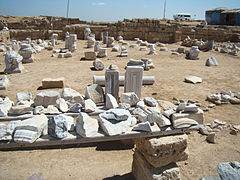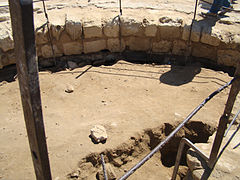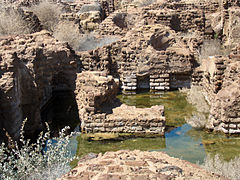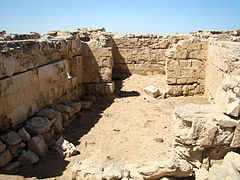Abu Mena
| UNESCO World Heritage Site | |
|---|---|
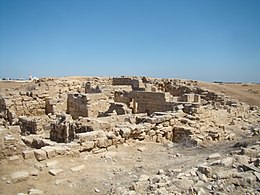 | |
| Location | Alexandria Governorate, Egypt |
| Criteria | Cultural: (iv) |
| Reference | 90 |
| Inscription | 1979 (3rd Session) |
| Endangered | 2001– |
| Area | 83.63 ha (0.3229 sq mi) |
| Coordinates | 30°50′28″N 29°39′49″E / 30.84105°N 29.66349°E |
Abu Mena (also spelled Abu
Recent agricultural efforts in the area have led to a significant rise in the water table, which has caused a number of the site's buildings to collapse or become unstable. The site was added to the List of World Heritage in Danger in 2001. Authorities were forced to place sand in the bases of buildings that are most endangered in the site.
History

Most versions of the story state that the location of the tomb was then forgotten until its miraculous rediscovery by a local shepherd. From the Ethiopian Synaxarium (E.A.W. Budge, trans.):
And God wished to reveal the [place of the] body of Saint Mînâs. And there was in that desert a certain shepherd, and one day a sheep which was suffering from the disease of the scab went to that place, and dipped himself in the water of the little spring which was near the place, and he rolled about in it and was healed straightway. And when the shepherd saw this thing, and understood the miracle, he marvelled exceedingly and was astonished. And afterwards he used to take some of the dust from that shrine, and mix it with water, and rub it on the sheep, and if they were ill with the scab, they were straightway healed thereby. And this he used to do at all times, and he healed all the sick who came to him by this means.
Word of the shepherd's healing powers spread rapidly. The synaxarium describes
During the reign of Arcadius, the local archbishop observed that crowds were overwhelming the small church. He wrote to the eastern emperor, who ordered a major expansion of the facilities, the first of three major church expansions which would eventually take place. By the end of Late antiquity, Abu Mena had become the leading pilgrimage site in Egypt.[8][9]
Abu Mena was destroyed during the early Muslim conquests of the mid-7th century.
Archaeological excavations
The site was first excavated from 1905 to 1907. These efforts uncovered a large basilica church, an adjacent church which had probably housed the
A later, long-term series of excavations by the
Threats
The site of Abu Mena was added to
Immediate action was taken to fill the bases of particularly important sites with sand and close them off to the public. In attempts to counteract this phenomenon, the Supreme Council of Antiquities spent 45 million digging trenches and adding pumps in hopes of decreasing the pressure of irrigation. In addition, a fence was added to prevent encroachment and threat.[12] These proved to be successful and the site was removed from UNESCO's World Heritage in Danger list in 2009.[13]
Since then, water has continued to rise and cause destruction of monuments. The site is once again on UNESCO's World Heritage in Danger list. Factors found to negatively impact the property most recently in 2018 include housing, management activities, managements systems/plan, and water. [14]
Conservation
Recent conservation endeavors at the site of Abu Mena involve the implementation of advanced drainage systems and community engagement programs to mitigate the ongoing threats posed by rising water levels and other factors. The Egyptian government has implemented emergency plans and indeed solved the problem with the water table, but the government does not currently have a thorough management plan or anything related to it. Since UNESCO requires a management plan for all the cultural and natural sites, several proposals have been made. The most reliable option is the use of a smart, sustainable membrane. It has been designed to solve issues with ventilation, energy, and water on the site. This plan involves building a dome-shaped smart membrane, which would provide the site an appropriate amount of airflow (as is required for every world heritage site). The smart-membrane dome would also provide a self-sustainable energy supply through solar cells located on the outside layer of the dome. The membrane would also be designed to have a filtration system for dehumidifying the air by filtering the water out of it so that the site can be better preserved.[15]
Gallery
-
Artifacts at Abu Mena
-
Artifacts at Abu Mena
-
Artifacts at Abu Mena
-
Basilica of The Crypt at Abu Mena
-
Basilica of The Crypt at Abu Mena
-
Basilica of The Crypt at Abu Mena
-
Baths at Abu Mena
-
Baths at Abu Mena
-
Baths at Abu Mena
-
Landscape at Abu Mena
-
Pilgrimage Centre at Abu Mena
-
Pilgrimage Centre at Abu Mena
-
Religious Complex at Abu Mena
-
Ruins of the Great Basilica at Abu Mena
-
Ruins at Abu Mena
See also
- List of ancient Egyptian towns and cities
- Church of Saint Menas (Cairo)
- Saint Fana
- Saint Mina Monastery in Mariut, the modern pilgrimage site, which borders the original Abu Mena site to the north
- World Heritage Sites in Danger
Notes
- ^ "Abu Mena". UNESCO World Heritage Centre. United Nations Educational, Scientific, and Cultural Organization. Retrieved 6 September 2021.
- ISBN 978-0-7864-3546-3.
- ^ Grossmann, Peter (1998). "The Pilgrimage Center of Abû Mînâ". in D. Frankfurter (ed.), Pilgrimage & Holy Space in Late Antique Egypt. Leiden-Boston-Köln, Brill: p. 282
- ^ "Record | The Cult of Saints". csla.history.ox.ac.uk. Retrieved 2023-08-12.
- JSTOR 1291860.
- S2CID 191762441.
- ^ Anderson, William. An Archaeology of Late Antique Pilgrim Flasks, Anatolian Studies, Vol. 54, (2004), pp. 79–93, British Institute at Ankara.
- ^ S2CID 194049544.
- JSTOR 3259887.
- JSTOR 3046689.
- ^ "Abu Mena: Indicators". UNESCO World Heritage Centre. Retrieved 2017-09-17.
- ^ "Abu Mena (Threats to the Site 2001)". UNESCO. UNESCO. Retrieved October 30, 2018.
- ^ Ramadan, Ragab. "Funding issues threaten preservation of Christian sanctuary". Egypt Independent. Al-Masry Al-Youm. Retrieved October 30, 2018.
- ^ "Abu Mena(Egypt)". UNESCO. UNESCO. Retrieved October 30, 2018.
- ^ "Smart Sustainable Membrane for Historical Sites Conservation, Case Study: Abu Mena, Alexandria". ResearchGate. Retrieved 2018-12-08.
Further reading
- O'Brien, Harriet (June 18, 2006). "The World's Most Remarkable Buildings Under Threat". The Independent. Archived from the original on 2012-11-04.
- ICOMOS Heritage at Risk 2001/2002
- ISBN 9780870991790
External links
- Abu Mena at UNESCO World Heritage Centre; includes links to 360˚ panoramic photos of the site




